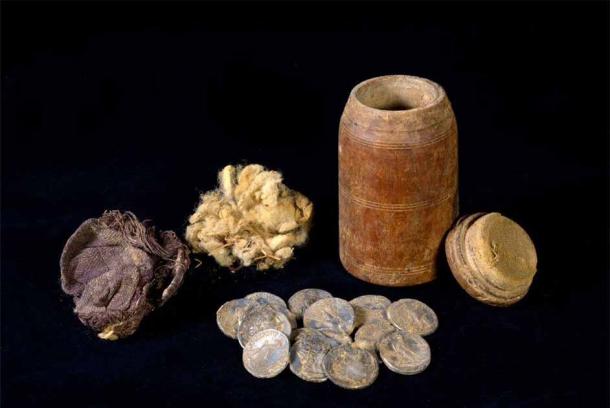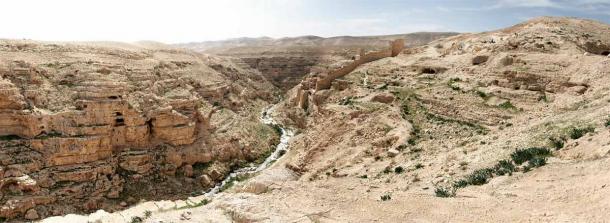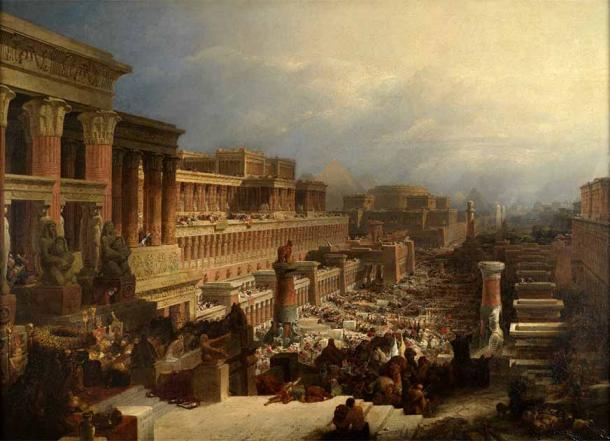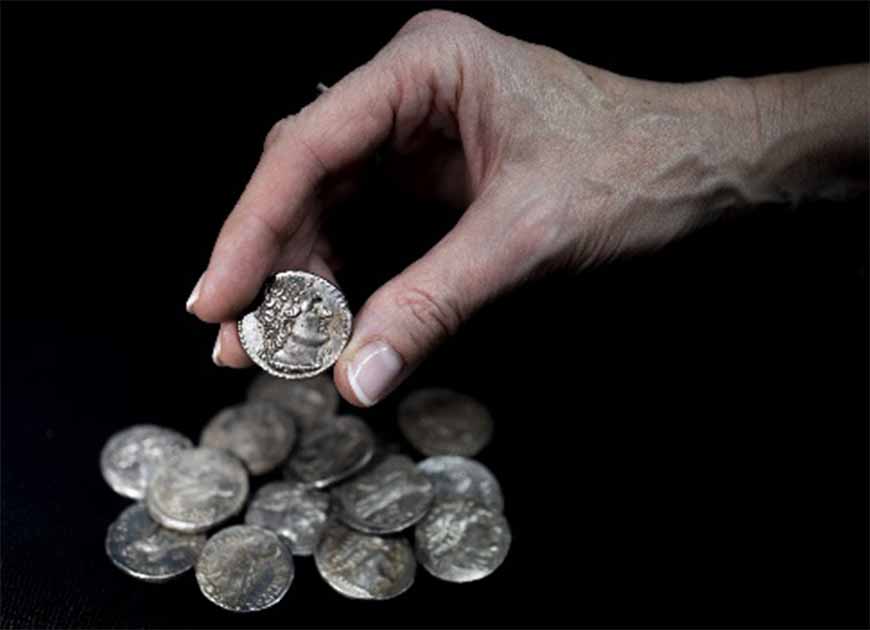Coins Minted by Egyptian King Ptolemy VI Found in Desert Cave
Archaeologists in the Judean desert have unearthed a small wooden box lined with sheepskin and a purple cloth. Within it, they discovered fifteen rare coins minted by Egyptian King Ptolemy VI, representing “the first evidence” of Jews fleeing to the Negev during the Jewish Revolt almost 2,200 years ago.
The Wadi Murabba’at is a deep ravine that was cut by a seasonal stream running from the Judean desert east of Bethlehem over millions of years, past Herodium to the Dead Sea. The hoard of silver coins was discovered in a cave last year and represents “the first solid evidence ever discovered” in the Judean Desert for the Maccabean Revolt against the Greek Seleucid Empire.

The discovery of this coin hoard dating to Ptolemy VI backs up the Biblical Jewish Exodus tale.Source: Israel Antiquities Authority
Sandstone Caves Loaded with Treasure
This entire region is dotted with sandstone caves, most of which were inhabited by farmers in ancient times. Four huge caves, known as the Wadi Murabba’at, were first discovered and explored by the Ta'amire Bedouin in 1952. In two of them, a collection of primitive agricultural tools dating to the Chalcolithic period (4th millennium BC) were found.

The Judean Desert has numerous caves in its sandstone mountains. The Ptolemy coin hoard was found in one of the Wadi Murabba’at caves, a site of previous archaeological discoveries (Pavel Bernshtam / Adobe Stock)
The other two caves revealed various layers of settlement dating to the Middle Bronze Age (18th-17th century BC) and from the Iron Age II (8th-7th century BC). Large jars, iron and bronze weapons as well as tools, coins, and implements made of wood, stone, leather, and bone, demonstrated that occupation of the four caves was most intense during the Roman period. In these two caves, several leather parchments were unearthed written in Hebrew, Aramaic, Greek, Latin, and Arabic, including fragments of the Minor Prophets and Exodus from the Old Testament.
Now, Eli Escusido, director of the Israel Antiquities Authority, said in a Facebook post that a container with “15 tetradrachm coins” discovered in one of the Wadi Murabba’at caves was buried in haste around 2,200 years ago, at the time of the Jewish Revolt, also known as the Maccabean Revolt.
- The Maccabean Revolt: The Jewish Rebellion Against the Seleucid Empire
- Seleucid Sling Stone Sheds New Light on Jewish Hannukah Story
Much of the Judean Desert is dotted with caves, such as this one, where a Ptolemy coin hoard was discovered (Israel Antiquities Authority)
A Ritually Wrapped and Packed Hoard
The tetradrachm was a large silver coin considered “the most important coinage in ancient Greece,” equivalent to four drachmae. The bottom of the container was lined with a protective sheep’s wool layer and purple cloth; the lid was packed with an upper layer of earth and small stones.
According to Heritage Daily, most of the fifteen coins were minted by the Macedonian King Ptolemy VI Philometor, the eldest son of King Ptolemy V and Queen Cleopatra I, who ruled Egypt between 180 and 164 BC and from 163 to 145 BC. History remembers Ptolemy VI’s conflict with the Seleucid Empire over control of what is today Syria. However, the most recent coin in the hoard dates from 170 BC, meaning it was in circulation during the Maccabean Revolt, or Jewish rebellion, of 167-160 BC.
- Hanukkah Origins: ‘Miracle of Oil’ Exalted a Religious Freedom Victory in Ancient Jewish Temple
- Evidence of Hanukkah Story Found in Razed Hellenistic Fortress
Is the Ptolemy Coin Hoard Evidence of Jewish Exodus from Egypt?
King Antiochus IV Epiphanes of the Seleucid (Syrian) Empire fiercely repressed the religious practices of the Jews in Israel, and the Maccabees rebelled in what is known as the Jewish uprising. These events are associated with the Jewish Hanukkah celebration, so the IAA Facebook post stated that the coins represent “a symbolic” and “moving” find. IAA told Ha’aretz that the cave had “famously sheltered Jews fleeing the Romans at the end of the ill-fated Bar Kochba revolt that began in 132 AD.” However, the newly unearthed collection of coins is “the first solid evidence” of people using the cave to hide centuries earlier, at the end of the Hasmonean period.

The Ptolemy coin hoard supports the Biblical tales of the Jewish Exodus. The Israelites leaving Egypt, 1830 oil painting by David Roberts (Public Domain)
Ptolemy Coin Hoard Only the Latest Discovery
This is not the first time coins have been discovered in the Wadi Murabba’at caves. It was the 1946 discovery of the Dead Sea Scrolls in the Qumran caves that led archaeologists and local people to explore other areas of the Judean wilderness looking for additional ancient documents. In October 1951, a group of local Bedouin farmers were harvesting guano-rich soil, which can be used as fertilizer, from the caves at Wadi Murabba’at when they unearthed a priceless ancient treasure.
The farmers approached the Rockefeller Museum with skin fragments displaying Hebrew and Greek writing. Over the next two months, archaeologist Roland de Vaux bought many more fragments from local antiquities dealers, who had obtained pieces of the ancient manuscripts from the caves at Wadi Murabba’at. The following year, he excavated the four caves, revealing several layers of artifacts and twenty coins, including nine from the Second Jewish War (132-5 AD).
Celebrating Artifacts from the Origins of Hanukkah
Coin expert Dr. Eitan Klein told Jewish News that ancient Jews most likely stashed their most valuable possessions in the Judean desert “until a certain danger was gone, such as those detailed in the Books of the Maccabees.”
Thus, the hoard of fifteen coins associated with the origins of Hanukkah festival, which commemorates the recovery of Jerusalem in the 2nd century BC, will be displayed to the public during Heritage Week on Hanukkah in the Hasmonean Museum in Modi‘in.
Top Image: The hoard of fifteen tetradrachm were found in a wooden container lined with sheepskin and cloth (Israel Antiquities Authority)
By Ashley Cowie
References
Bench, C. 2015. Wadi Murabba’at, Archaeology of. n.p. in Lexham Bible Dictionary, J. D. Barry, et al. (eds). Lexham Press.
Confino, J. December 13, 2022. Chanukah comes early! Maccabean silver coins found in Judean desert. Jewish News. Available at: https://www.jewishnews.co.uk/chanukah-comes-early-maccabean-silver-coins-found-in-judean-desert/
Greece, Attica, AR Tetradrachma. n.d. Emporium Numismatics. Available at: https://www.emporium-numismatics.com/Greece-Attica-AR-Tetradrachma
Jewish Revolt Coin Hoard Discovered in Desert Cave. December 14, 2022. Israel Antiquities Authority via Facebook. Available at: https://www.facebook.com/AntiquitiesEN/posts/pfbid02Pr7YQ6P38mZLuRBdr8CAgSPqggXQ3NMZGvHajJDa6qpzAupNaTVpp9Go72bZbcatl
Schuster, R. December 13, 2022. Israeli Archaeologists Find First Proof That Jews Fled to the Negev After Failed Revolt 2,200 Years Ago. Ha’aretz. Available at: https://www.haaretz.com/archaeology/2022-12-13/ty-article/israeli-archaeologists-find-proof-that-jews-fled-to-negev-after-revolt-2-200-years-ago/00000185-0699-dd32-a9cf-eef997d10000
The Dead Sea Scrolls – H. Wadi Murabba’at. n.d. Biblical Studies. Available at: https://biblicalstudies.org.uk/pdf/scripture/07-3_066.pdf



















Comments
Its interesting that noone can seem to agree on the specific timeline or even the pharoah.. this is a problem when somone is trying to prove again the old testament truths.. the dead sea beinf sodom n Gomorrah thats being investigated, the david coins, there is so much historical evidence why is it so hard for people to accept the concept of extra dimensional and/or extraterrestrial interference in our history? Cuz its in the bible too(as well as the tablets of enki)
Now personally being from the tribe of naphtali(celts) but not being a jew (the Babylonian corruption, as well as being edomic.. not Israelite.. ) i also enjoy when the limited history that is the bible gets more proof. Now wheres the sumerian, and the ethinic indians, and the tibetans, and the mesoamericans.. there were 7 fallen(and significant others) 7 cultures created.. y do we focus so much of just one of the stories?? The others could just as easily be true oral records of history as well... This will also be my last opinion here . Ive quit being an evangelical truthseeker.. its absolutely useless.. humanity is too stupid, (by design) to follow the path.. much love if u seek truth, but even here they sometimes half ass it
infinitesimal waveparticles comprise what we call home the earth
manipulatable by thought ability supressed in humans since birth
I don’t think you could post a more poignant story during Hanukkah. So much of our past, as Jews, is steeped in myth and not easily proven. When we find something like this, it bolsters our belief in both the Bible and the stories we hear from our parents and rabbis.
So, thank you for this and to all archaeologists out there: keep digging and discovering our past. It’s priceless.
Jewish ‘Exodus’ out of Egypt more fits the Hyksos expulsion of 1650 BC. To try to incorporate these coins into the story is a stretch.
Nobody gets paid to tell the truth.